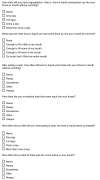GERD symptoms in the general population: prevalence and severity versus care-seeking patients
- PMID: 24811245
- PMCID: PMC4275099
- DOI: 10.1007/s10620-014-3181-8
GERD symptoms in the general population: prevalence and severity versus care-seeking patients
Abstract
Background: Prior estimates suggest that up to 40% of the US general population (GP) report symptoms of gastroesophageal reflux disease (GERD). However, symptoms in the GP versus patients seeking care for gastrointestinal (GI) complaints have not been compared. We estimated the prevalence and severity of GERD symptoms in the GP versus GI patients, and identified predictors of GERD severity. We hypothesized that similar to functional GI disorders, psychosocial factors would predict symptom severity in GERD as much, or perhaps more, than care-seeking behavior alone.
Methods: We compared the prevalence of heartburn and regurgitation between a sample from the US GP and patients seeking GI specialty care. We compared GERD severity between groups using the NIH PROMIS(®) GERD scale. We then performed multivariable regression to identify predictors of GERD severity.
Results: There was no difference in the prevalence of heartburn between the GP and patient groups (59 vs. 59%), but regurgitation was more common in patients versus GP (46 vs. 39%; p = 0.004). In multivariable regression, having high visceral anxiety (p < 0.001) and being divorced or separated (p = 0.006) were associated with higher GERD severity.
Conclusions: More than half of a GP sample reports heartburn-higher than previous series and no different from GI patients. Although regurgitation was more prevalent in patients versus the GP, there was no difference in GERD severity between groups after adjusting for other factors; care seeking in GERD appears related to factors beyond symptoms, including visceral anxiety.
Figures



References
-
- Tack J, Becher A, Mulligan C, et al. Systematic review: the burden of disruptive gastro-oesophageal reflux disease on health-related quality of life. Aliment Pharmacol Ther. 2012;35:1257–1266. - PubMed
-
- Becher A, El-Serag H. Systematic review: the association between symptomatic response to proton pump inhibitors and health-related quality of life in patients with gastro-oesophageal reflux disease. Aliment Pharmacol Ther. 2011;34:618–627. - PubMed
-
- El-Serag HB. Time trends of gastroesophageal reflux disease: a systematic review. Clin Gastroenterol Hepatol. 2007;5:17–26. - PubMed
-
- A Gallup survey on heartburn across America. The Gallup Organization, Inc.; Princeton, NJ: 1988.
-
- Agreus L, Svardsudd K, Talley NJ, et al. Natural history of gastroesophageal reflux disease and functional abdominal disorders: a population-based study. Am J Gastroenterol. 2001;96:2905–2914. - PubMed
Publication types
MeSH terms
Grants and funding
- P30-AG028748/AG/NIA NIH HHS/United States
- U01 AR052177/AR/NIAMS NIH HHS/United States
- 1 T32 AR053463/AR/NIAMS NIH HHS/United States
- AR052177/AR/NIAMS NIH HHS/United States
- P20 MD000182/MD/NIMHD NIH HHS/United States
- T32 AR053463/AR/NIAMS NIH HHS/United States
- P50 DK064539/DK/NIDDK NIH HHS/United States
- P50 DK64539/DK/NIDDK NIH HHS/United States
- U01 AR057936A/AR/NIAMS NIH HHS/United States
- P30 AG021684/AG/NIA NIH HHS/United States
- P30 AG028748/AG/NIA NIH HHS/United States
- K24 AR063120/AR/NIAMS NIH HHS/United States
- U01 AR057936/AR/NIAMS NIH HHS/United States
- 2P20MD000182/MD/NIMHD NIH HHS/United States
LinkOut - more resources
Full Text Sources
Other Literature Sources
Medical

